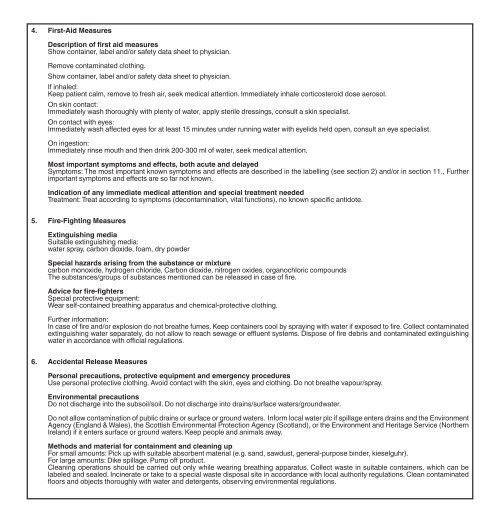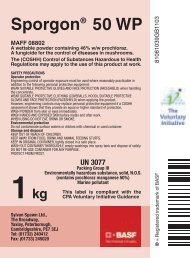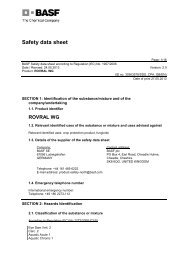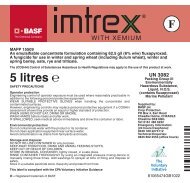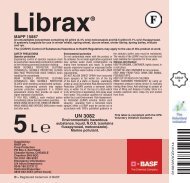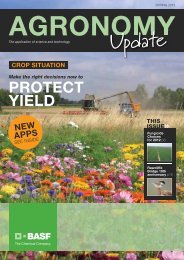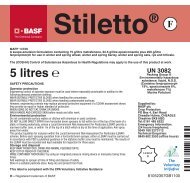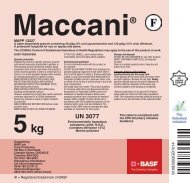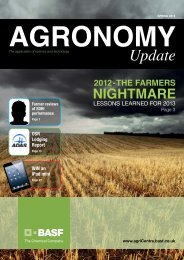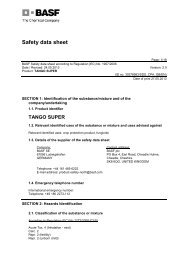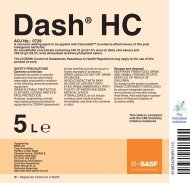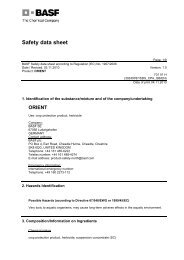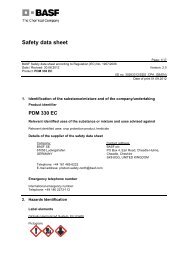Meteor® - agriCentre UK - BASF
Meteor® - agriCentre UK - BASF
Meteor® - agriCentre UK - BASF
You also want an ePaper? Increase the reach of your titles
YUMPU automatically turns print PDFs into web optimized ePapers that Google loves.
4. First-Aid Measures<br />
Description of first aid measures<br />
Show container, label and/or safety data sheet to physician.<br />
Remove contaminated clothing.<br />
Show container, label and/or safety data sheet to physician.<br />
If inhaled:<br />
Keep patient calm, remove to fresh air, seek medical attention. Immediately inhale corticosteroid dose aerosol.<br />
On skin contact:<br />
Immediately wash thoroughly with plenty of water, apply sterile dressings, consult a skin specialist.<br />
On contact with eyes:<br />
Immediately wash affected eyes for at least 15 minutes under running water with eyelids held open, consult an eye specialist.<br />
On ingestion:<br />
Immediately rinse mouth and then drink 200-300 ml of water, seek medical attention.<br />
Most important symptoms and effects, both acute and delayed<br />
Symptoms: The most important known symptoms and effects are described in the labelling (see section 2) and/or in section 11., Further<br />
important symptoms and effects are so far not known.<br />
Indication of any immediate medical attention and special treatment needed<br />
Treatment: Treat according to symptoms (decontamination, vital functions), no known specific antidote.<br />
5. Fire-Fighting Measures<br />
Extinguishing media<br />
Suitable extinguishing media:<br />
water spray, carbon dioxide, foam, dry powder<br />
Special hazards arising from the substance or mixture<br />
carbon monoxide, hydrogen chloride, Carbon dioxide, nitrogen oxides, organochloric compounds<br />
The substances/groups of substances mentioned can be released in case of fire.<br />
Advice for fire-fighters<br />
Special protective equipment:<br />
Wear self-contained breathing apparatus and chemical-protective clothing.<br />
Further information:<br />
In case of fire and/or explosion do not breathe fumes. Keep containers cool by spraying with water if exposed to fire. Collect contaminated<br />
extinguishing water separately, do not allow to reach sewage or effluent systems. Dispose of fire debris and contaminated extinguishing<br />
water in accordance with official regulations.<br />
6. Accidental Release Measures<br />
Personal precautions, protective equipment and emergency procedures<br />
Use personal protective clothing. Avoid contact with the skin, eyes and clothing. Do not breathe vapour/spray.<br />
Environmental precautions<br />
Do not discharge into the subsoil/soil. Do not discharge into drains/surface waters/groundwater.<br />
Do not allow contamination of public drains or surface or ground waters. Inform local water plc if spillage enters drains and the Environment<br />
Agency (England & Wales), the Scottish Environmental Protection Agency (Scotland), or the Environment and Heritage Service (Northern<br />
Ireland) if it enters surface or ground waters. Keep people and animals away.<br />
Methods and material for containment and cleaning up<br />
For small amounts: Pick up with suitable absorbent material (e.g. sand, sawdust, general-purpose binder, kieselguhr).<br />
For large amounts: Dike spillage. Pump off product.<br />
Cleaning operations should be carried out only while wearing breathing apparatus. Collect waste in suitable containers, which can be<br />
labeled and sealed. Incinerate or take to a special waste disposal site in accordance with local authority regulations. Clean contaminated<br />
floors and objects thoroughly with water and detergents, observing environmental regulations.


